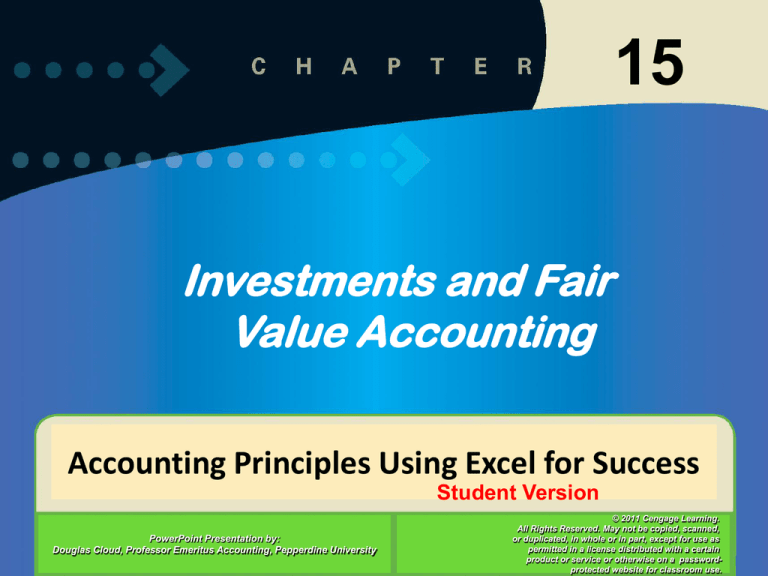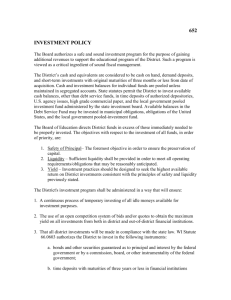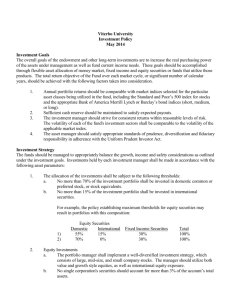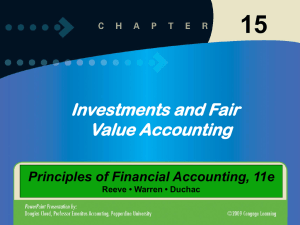
15
Investments and Fair
Value Accounting
Accounting Principles Using Excel for Success
15-1
11-1
PowerPoint Presentation by:
Douglas Cloud, Professor Emeritus Accounting, Pepperdine University
Student Version
© 2011 Cengage Learning.
All Rights Reserved. May not be copied, scanned,
or duplicated, in whole or in part, except for use as
permitted in a license distributed with a certain
product or service or otherwise on a passwordprotected website for classroom use.
1
Describe why
companies invest in
debt and equity
securities.
15-2
11-2
1
Investing Cash in Temporary
Investments
Debt securities are notes and bonds that
pay interest and have a fixed maturity
date. Equity securities are preferred and
common stock that represent ownership
in a company and do not have a fixed
maturity date.
15-3
11-3
1
Investing Cash in Temporary
Investments
These debt securities and equity
securities are termed Investments, or
Temporary Investments, and are
reported in the Current Assets section
of the balance sheet.
15-4
11-4
1
Investing Cash in Long-Term
Investments
Long-term investments often involve the
purchase of a significant portion of the stock
of another company. Such investments have a
strategic purpose:
1. Reduction of costs
2. Replacement of management
3. Expansion
4. Integration
15-5
11-5
2
Describe and illustrate
the accounting for debt
investments.
15-6
11-6
2
Purchase of Bonds
Homer Company purchases $18,000 of U.S. Treasury
bonds direct from a Federal Reserve Bank at their par value
on March 17, 2010 (45 days after the last interest payment
date). The bonds have an interest rate of 6%, payable on
July 31 and January 31.
$18,000 × 6% × (45/360)
15-7
11-7
2
Interest Revenue
On July 31, Homer Company receives a semiannual
interest payment of $540 ($18,000 × 6% × ½).
($540 – $135) or [$18,000 × 6% ×
(135/360)]
15-8
11-8
2
Accrued Interest
Homer Company’s accounting period ends on December
31. The following adjusted entry is required to record the
accrued interest:
Homer Company would report Interest Revenue on its
2010 income statement at $855 ($405 + $450).
15-9
11-9
2
Semiannual Receipt of Interest
Homer Company receives interest of $540 on
January 31, 2011. Notice that Interest Receivable is
credited for $450 to reflect this is a receivable from
2010. Interest Revenue of $90 is the interest earned
from January 1 through January 31, 2011.
15-10
11-10
2
Sale of Bonds
On January 31, 2011, Homer Company sells Treasury
bonds at 98. The sale results in a loss of $360.
Proceeds from sale ($18,000 × 98%)
Less book value (cost) of the bonds
Loss on sale of bonds
15-11
11-11
$17,640
18,000
$(360)
Reported as part of Other Income
(Loss) on the income statement
3
Describe and illustrate
the accounting for
equity investments.
11-12
15-12
3
Less Than 20% Ownership
Investments of less than 20%
of the investee’s outstanding
stock are accounted for by
using the cost method.
15-13
11-13
3
Purchase of Stock (Cost Method)
On May 1, Bart Company purchases 2,000 shares of Lisa
Company common stock at $49.90 per share plus a
brokerage fee of $200.
15-14
11-14
3
Receipt of Dividends (Cost Method)
On July 31, Bart Company receives a dividend of $0.40
per share from Lisa Company.
Dividend Revenue is reported as part of Other Income on
Bart Company’s income statement.
15-15
11-15
3
Sale of Stock (Cost Method)
On September 1, Bart Company sells 1,500 shares of Lisa
Company stock for $54.50 per share, less a $160
commission.
Proceeds from sale [(54.50 × 1,500 shares) – $160
Book value (cost) of the stock ($100,000/2,000 shares) × 1,500
Gain on sale of investments
15-16
11-16
$81,590
75,000
$ 6,590
3
Between 20% and 50% Ownership
If the investor purchases between 20%
and 50% of the outstanding stock of the
investee, the investor is considered to
have significant influence over the
investee and the investment is accounted
for using the equity method.
15-17
11-17
3
Purchase of Stock (Equity Method)
Simpson Inc. purchased a 40% interest in Flanders
Corporation’s common stock on January 2, 2010, for
$350,000.
15-18
11-18
3
Recording Investee Net Income
(Equity Method)
For the year ending on December 31, 2010, Flanders
Corporation reported net income of $105,000.
Income of Flanders Corporation, if significant, is reported
as Other Income on Simpson Inc.’s income statement.
15-19
11-19
3
Recording Investee Dividends
(Equity Method)
During the year, Flanders declared and paid cash dividends
of $45,000.
15-20
11-20
3
Sale of Stock (Equity Method)
On January 1, 2011, Simpson Inc. sold Flanders
Corporation’s stock for $400,000 a gain of $26,000
calculated as follows:
Proceeds from sale
Book value of stock investment
Gain on sale
15-21
11-21
$400,000
374,000
$ 26,000
3
More Than 50% Ownership
If the investor purchases more than 50%
of the outstanding stock of the investee,
the investor is considered to have control
over the investee. The purchase is termed
a business consolidation.
15-22
11-22
4
Describe and illustrate
valuing and reporting
investments in the
financial statements.
11-23
15-23
4
Trading Securities
Maggie Company purchased a portfolio of trading
securities during 2009. On December 31, 2009, the
cost and fair values of the securities were as
follows:
15-24
11-24
4
The adjusting entry on December 31, 2009, to
record the fair value of the securities is as follows:
The Unrealized Gain on Trading Investments, if
significant, is reported on the income statement.
15-25
11-25
4
15-26
11-26
4
On September 10, 2010, Maggie Company
purchases 300 shares of Zane Inc. as a trading
security for $12 per share, including a brokerage
commission.
15-27
11-27
4
On December 31, 2010, the cost and fair
valuation of the portfolio of trading securities
are as follows:
15-28
11-28
4
Based on the above analysis, the adjusting entry
on December 31, 2010, is as follows:
15-29
11-29
4
The valuation allowance for trading investments
account after the December 31, 2010, adjusting
entry has a credit balance of $3,100.
Valuation Allowance for Trading Investments
2009
Dec. 31 Adj.
Dec. 31 Bal.
1,300
1,300
2010
Jan.
1 Bal.
1,300
2010
Dec. 31 Adj.
Dec. 31 Bal.
15-30
11-30
4,400
3,100
4
15-31
11-31
4
Held-To-Maturity Securities
Held-to-maturity
securities are debt
investments, such as
notes or bonds, that a
company intends to
hold until their
maturity date.
15-32
11-32
4
Available-For-Sale Securities
Available-for-sale
securities are debt
and equity
securities that are
not classified as
trading or held-formaturity securities.
15-33
11-33
4
Maggie Company purchased securities during
2009 as available-for-sale securities instead of
trading securities. On December 31, 2009, the
cost and fair values of the securities are as
follows:
15-34
11-34
4
The adjusting entry on December 31, 2009, to
record the fair value of the securities is as follows:
15-35
11-35
4
On September 10, 2010, Maggie Company
purchases 300 shares of Zane Inc. as an
available-for-sale security for $12 per share,
including brokerage commission.
15-36
11-36
4
On December 31, 2010, the cost and fair
valuation of the portfolio of available-forsale securities are as follows:
15-37
11-37
5
Describe fair value
accounting and its
implications for the
future.
11-38
15-38
5
Fair Value Accounting
Fair value is the price that would be
received for selling an asset or paying
off a liability. Fair value assumes that
the asset is sold or the liability paid off
under normal rather than under distress
conditions.
15-39
11-39
5
Disadvantages of Fair
Value Accounting
Several potential disadvantages
include the following:
1. Fair value may not be readily obtainable
for some assets or liabilities resulting in
subjectivity.
(continued)
15-40
11-40
5
2. Fair values make it more difficult to
compare companies if companies use
different methods of determining
(measuring) fair values.
3. Using fair values will result in more
fluctuations in accounting reports
because fair values normally change
from year to year.
15-41
11-41
15-42
11-42








